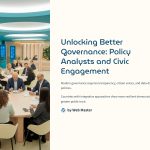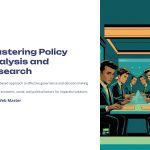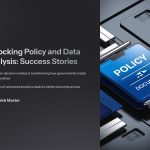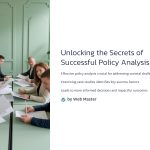 What if your next public decision could be 10x more effective, backed by real data? In a world flooded with information, the need for data-driven policy decisions is skyrocketing. The collaboration between policy analysts and data analysts is no longer optional—it’s a game-changer. Governments and public institutions are increasingly adopting AI, machine learning, and statistical modeling to shape better outcomes. The synergy between sharp policy interpretation and data clarity has already shown transformational results in areas like urban planning, healthcare, and climate policy. This article explores how integrating policy analysis with advanced data outcomes is setting new benchmarks in public strategy, what tools are trending, and how the future of governance is being reshaped by this dynamic duo.
What if your next public decision could be 10x more effective, backed by real data? In a world flooded with information, the need for data-driven policy decisions is skyrocketing. The collaboration between policy analysts and data analysts is no longer optional—it’s a game-changer. Governments and public institutions are increasingly adopting AI, machine learning, and statistical modeling to shape better outcomes. The synergy between sharp policy interpretation and data clarity has already shown transformational results in areas like urban planning, healthcare, and climate policy. This article explores how integrating policy analysis with advanced data outcomes is setting new benchmarks in public strategy, what tools are trending, and how the future of governance is being reshaped by this dynamic duo.

The Role of Policy Analysts in Modern Governance
Policy analysts are the strategists of the public sector. Their main role is to interpret legislative goals, assess societal needs, and propose actionable recommendations. They bridge the gap between political objectives and real-world implementation. Unlike general advisors, policy analysts rely heavily on evidence-based practices and predictive forecasting to validate their suggestions.
In modern contexts, especially post-pandemic, their roles have expanded to include understanding behavioral economics, demographic transitions, and environmental sustainability. They no longer just draft policy papers—they now analyze data dashboards, collaborate with IT teams, and brief decision-makers with performance metrics. The rise of e-government systems means that policy analysts need to interpret digital feedback and respond in real-time. This evolution demands a new skillset that blends qualitative insight with quantitative literacy.

How Data Analysts Translate Numbers into Public Value
Data analysts, by contrast, turn raw information into structured knowledge. Their work involves gathering datasets, cleaning them, performing statistical analysis, and presenting outcomes that guide public decisions. Their main weapon is clarity—without it, even the best policy ideas can fall flat.
In policy contexts, they often work on areas like traffic congestion, public health trends, taxation efficiency, or climate adaptation. Tools such as R, Python, Tableau, and GIS platforms enable them to craft visuals and simulations that expose systemic risks or emerging opportunities. A well-crafted dataset can tell a story of inequality, success, or transformation better than any speech or document.
As AI and automation become embedded in public infrastructures, data analysts are also required to explain machine-learning outcomes, ensure data ethics, and monitor algorithmic fairness. Their ability to translate mathematical insights into social relevance is what gives data analysts a critical place at the policymaking table.

Real-World Examples Where Policy Meets Data
Across the globe, the integration of policy and data analytics is producing measurable results. In Canada, for example, data-driven homelessness policies reduced chronic street-living cases by nearly 20% in some provinces. In South Korea, public transport policies adjusted in real-time through GPS and commuter data have decreased urban congestion by double digits.
Another standout case is in Nairobi, where smart city models powered by IoT sensors feed into city council dashboards, enabling weekly adjustments to energy and waste policy. In these instances, data analysts develop the models, but it’s the policy analysts who advocate for and implement responsive changes based on those models.
The magic happens in the collaboration—when insight meets action. This tandem transforms planning into execution, and ideas into outcomes.

Tools and Techniques Empowering Both Roles
Policy and data analysts are increasingly using shared platforms. Tools like Power BI, ArcGIS, Stata, and open-data APIs now form the common ground between the two fields. They empower joint scenario analysis, simulations, and stakeholder visualizations that drive strategic conversations.
Methods like regression analysis, Monte Carlo simulations, and time-series forecasting are no longer niche—they’re being taught to policymakers in certificate programs. Likewise, data experts are being trained in legal frameworks, public values, and participatory governance.
Collaborative dashboards allow both actors to track live indicators, simulate the impact of hypothetical policies, and adjust recommendations accordingly. The rise of no-code analytics tools also enables cross-functional teams to test hypotheses without needing hardcore programming skills.

Challenges in Synchronizing Policy and Data Disciplines
Despite the clear benefits, merging policy and data practices isn’t always smooth. Organizational silos, legacy systems, and political timelines can hinder efficient collaboration. In many agencies, policy teams still rely on narrative-heavy reports while data teams push for numeric evidence.
Another challenge lies in interpretation—while data may suggest one direction, political or social constraints may lead to different paths. Ensuring transparency and ethical integrity in such decisions is essential. Data integrity, privacy concerns, and algorithmic bias remain hot-button issues in government analytics.
Overcoming these hurdles requires not just tech upgrades, but cultural change. Interdisciplinary training, executive buy-in, and shared KPIs (Key Performance Indicators) are the beginning steps toward full integration.

Future Trends and Career Opportunities in the Field
As we look ahead, the blend of policy and data promises to reshape public institutions. Emerging areas like predictive governance, digital twins of cities, and sentiment analysis of civic feedback are pushing boundaries. Careers at the intersection of policy and data are booming, with hybrid roles like “policy data strategist” or “civic technologist” in high demand.
Governments are investing in interdisciplinary fellowship programs, hackathons, and innovation labs to bridge the gap. The private sector is also stepping in, offering analytics-as-a-service to public agencies. This not only enhances capabilities but also fosters a culture of data democratization.
For professionals, upskilling is critical. Certifications in both data science and public policy, combined with internships or collaborative projects, can create unique profiles that are future-proof and high-impact.
*Capturing unauthorized images is prohibited*







